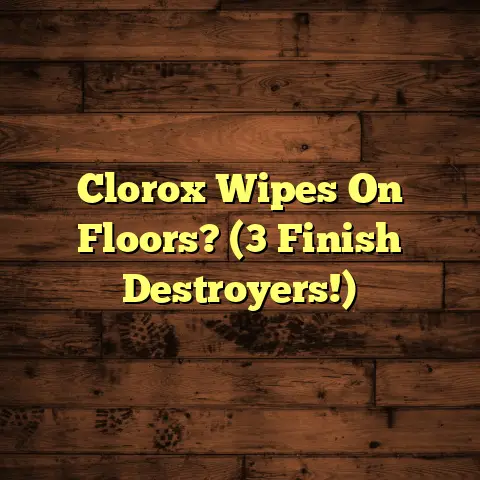How To Strip Wax From A Laminate Floor? (Explained)
Have you ever walked into a room and immediately felt that something was off? Perhaps it was the shine of your laminate floor, which used to be vibrant but now appears dull and sticky due to layers of wax buildup. If you can relate, you’re not alone. Many homeowners, including myself, have faced this issue. Stripping wax from laminate floors is not just about aesthetics; it’s essential for maintaining the integrity and longevity of the flooring.
Understanding Wax Buildup on Laminate Floors
Laminate flooring is a popular choice for many because of its durability and ease of maintenance. However, when wax is applied, it can create a glossy layer that attracts dirt and grime over time. This buildup can dull the finish and make the floor look unkempt. To restore its original beauty, I learned that stripping the wax is necessary.
What is Laminate Flooring?
Before diving deeper, let’s clarify what laminate flooring is. Laminate flooring consists of multiple layers fused together through a lamination process. The top layer is a transparent wear layer that protects against scratches and moisture, followed by a design layer that mimics wood or stone, a core layer for stability, and finally, a backing layer for moisture resistance. This structure makes laminate both cost-effective and versatile, suitable for various settings.
The Importance of Regular Maintenance
Maintaining laminate flooring is crucial to extending its lifespan. Regular cleaning, avoiding harsh chemicals, and understanding the products we use on our floors are essential components of care. I’ve found that many homeowners mistakenly think that applying wax will improve the appearance of their laminate floors, but in reality, it can lead to buildup that requires stripping.
Initial Steps: Assessing the Situation
Before diving into the cleaning process, I took a step back to assess the level of wax buildup on my floor. I noticed that certain areas were stickier than others, particularly near entryways where dirt and debris accumulated. I estimated about 200 square feet of my living room needed attention, which meant budgeting both time and resources effectively.
Identifying Wax Accumulation
To determine if you have wax buildup, look for the following signs:
- Sticky Residue: If your floor feels tacky even after cleaning, it’s likely due to wax.
- Dull Appearance: A shiny surface that has lost its luster can indicate buildup.
- Dirt Trapping: Wax can trap dirt, making regular cleaning less effective.
The Tools of the Trade
To tackle this project efficiently, I gathered a few essential tools:
- A commercial wax stripper designed for laminate floors
- A mop and bucket
- Clean microfiber cloths
- Warm water
- A scrub brush with soft bristles
- FloorTally to help with cost estimates and project planning
Using FloorTally was a game-changer. It provided accurate cost estimates for the wax stripper and other materials I would need, allowing me to budget around $50 for the entire project. Knowing the local rates for products saved me from overspending.
Selecting the Right Wax Stripper
When choosing a wax stripper specifically formulated for laminate floors, I came across several options in my local hardware store. Here are some examples:
- Zep Commercial Floor Stripper: Known for its effectiveness in removing wax buildup, it’s safe for laminate and hardwood.
- Bona Hard-Surface Floor Cleaner: This product is gentle yet effective, making it ideal for routine maintenance.
- Armstrong Once ‘n Done: A versatile cleaner that works well on various surfaces.
After reading reviews and doing a bit of research, I decided to go with Zep Commercial Floor Stripper due to its high ratings among users.
Step-by-Step Guide to Stripping Wax
Preparation
Before starting, I cleared the floor of any furniture and swept thoroughly to remove dust and debris. Preparation can significantly impact the effectiveness of your cleaning process.
- Clear the Area: Move all furniture and items off the floor.
- Sweep or Vacuum: Ensure no loose dirt or debris interferes with the cleaning solution.
Testing the Wax Stripper
I followed the instructions on the commercial wax stripper, applying a small amount on an inconspicuous area first to ensure it wouldn’t damage the laminate. This test area allowed me to assess how well the stripper worked without risking damage to a larger space.
Application
I mixed the wax stripper with warm water as directed and used a mop to apply it across the floor in small sections, working my way from one end of the room to the other.
- Mixing Solution: Always follow the manufacturer’s instructions for dilution ratios.
- Sectioning Off Areas: Focus on small sections (about 4×4 feet) to ensure thorough coverage.
Scrubbing
After letting it sit for about 10 minutes, I used a scrub brush to gently scrub the area. I found that using circular motions worked best to lift the wax without damaging the laminate surface.
- Gentle Pressure: Avoid using excessive force; let the stripper do most of the work.
- Use Soft Bristles: A scrub brush with soft bristles prevents scratching while effectively removing wax.
Rinsing
Once I removed the wax, I rinsed the area with clean water using a mop, ensuring no residue remained.
- Change Water Frequently: To avoid reapplying wax residue, change your rinse water often.
- Thoroughly Mop: Ensure all stripper is removed to avoid slippery surfaces once dry.
Drying
Finally, I used microfiber cloths to dry the floor completely. This step is crucial because any leftover moisture can lead to further damage.
- Air Circulation: Open windows or use fans to enhance drying.
- Avoid Walking on Wet Floors: Prevents slipping and ensures thorough drying before use.
Challenges Encountered
Despite my careful planning, I encountered a few challenges along the way. In some areas, especially where the wax was thickest, I had to repeat the application process multiple times. This added an extra hour to my project timeline. Additionally, I learned that not all wax strippers are created equal; some are more effective than others. After trying two different brands, I found one that worked significantly better—with a cost difference of only $10 but worth every penny.
Comparing Different Methods
While I opted for a commercial wax stripper, some alternative methods are available for removing wax from laminate floors:
- Vinegar Solution: A mixture of vinegar and warm water can help break down wax but may require more scrubbing.
- Baking Soda Paste: Combining baking soda with water creates a paste that can lift wax without harsh chemicals.
- Commercial Cleaners: Besides wax strippers, there are many all-purpose cleaners advertised as safe for laminate flooring.
In my experience, commercial strippers provided quicker results compared to homemade solutions. However, if you prefer natural methods or have sensitive areas like children’s playrooms, vinegar or baking soda can be effective alternatives.
Helpful Tips for Success
- Choose the Right Wax Stripper: Always opt for a product specifically designed for laminate floors to avoid damaging your flooring.
- Work in Small Sections: This approach allows you to monitor progress effectively and ensures no area dries out before you can rinse it.
- Be Patient: If you encounter stubborn wax spots, don’t rush. Apply more stripper and give it additional time to work.
- Stay Safe: Ensure good ventilation while working with chemical strippers and wear gloves to protect your hands.
- Follow Up with Maintenance: Once stripped and cleaned, consider applying a protective sealant designed for laminate floors to prevent future buildup.
The Final Result
After completing the cleaning process, I stepped back to admire my work. The floor looked almost brand new—glossy without being sticky. The effort put into stripping away layers of wax paid off significantly; I could see reflections in my floor again!
Regular Maintenance After Wax Removal
To prevent future buildup after stripping wax from my laminate floors, I adopted a few regular maintenance practices:
- Routine Cleaning: I started using a damp mop with a gentle cleaner designed for laminate floors once a week.
- Avoid Wax Products: I educated myself about products suitable for laminate flooring and steered clear of those containing wax.
- Quick Attention to Spills: Addressing spills immediately helps prevent any potential staining or buildup.
Conclusion
Stripping wax from laminate floors can be a straightforward task if you approach it with proper planning and tools. Using FloorTally not only helped me budget effectively but also ensured I had everything needed for a successful project. In my experience, restoring laminate floors has been rewarding—transforming a dull and sticky surface into one that shines again was worth the effort.
In summary, while there are various methods for cleaning laminate flooring, stripping wax effectively restores its beauty and prolongs its life. Whether you choose to do it yourself or hire a professional, understanding the process can help you make informed decisions for maintaining your home’s flooring.
I hope this guide serves you well in your journey toward beautiful laminate floors! If you have any experiences or tips you’d like to share about maintaining or restoring laminate flooring, feel free to reach out!





